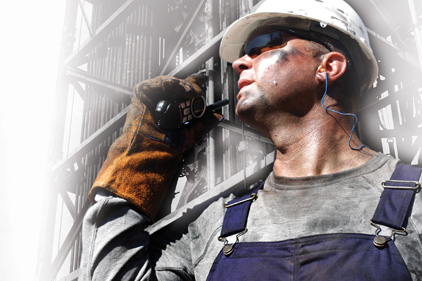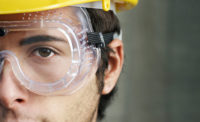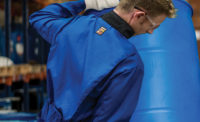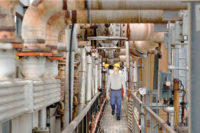| Tips to avoid heat stress |
Heat stress can manifest itself in many ways including heat rashes, heat cramps, heat exhaustion and, ultimately, heat stroke.
Know the typical warning signs
Identifying heat stress warning signs allows workers to take the appropriate steps to get the situation under control. Watch for headaches, lightheadedness, dizziness, unusual fatigue, irritability, confusion, nausea/vomiting, cramping and diarrhea.
This illustration below shows the temperature and humidity levels in which heat stroke becomes dangerous.
How the body cools itself
The body continually generates heat that must be released in order to maintain the proper core temperature of 98.6°F. The body responds to the increased temperature by circulating more blood to the skin, which allows the body to radiate more heat into the air. If heat loss from increased blood circulation is not adequate, the brain signals the sweat glands in the skin to release sweat. As the sweat evaporates, it draws the energy to vaporize from the rest of the sweat on the skin, leaving cooler moisture on the skin, which helps reduce the overall core temperature. This is called evaporative cooling.
There are four basic mechanisms to cooling the body.

Radiation – Almost 65 percent of all body heat is lost through radiation. This occurs when the heat from the skin is absorbed by the surrounding cooler air.
Convection – Approximately 10 percent of body cooling comes from heat transfer due to moving cool air (breeze, fan) across the skin to encourage evaporation and heat loss.
Conduction – Approximately 2 percent of body heat is pulled away by direct contact with a cooler object. The heat on the skin is transferred to the cooler object in contact with the skin.
Evaporation Cooling – Normally 23 percent occurs when moisture on the skin’s surface (sweat) evaporates, taking heat away and leaving cooler moisture and skin.
With summer approaching, temperatures in many parts of the country will soon be reaching well into the 90s with relative humidities surpassing 60 percent. In these conditions, the effectiveness of the body’s cooling mechanisms is significantly hampered. Radiation ceases to occur as the air and skin temperatures equalize. Convection stops as the moving air is now hot rather than cool. If there is nothing cool to touch, conduction is not an option. If the air is saturated with moisture, the evaporation of sweat will not happen.
In these extreme heat and humidity conditions, the body can no longer keep up with internal heat levels, and the body’s core temperature rises. The body’s reaction is to pump more blood to the skin which takes blood and fluids from the brain, muscles and major organs. The heart pumps harder to keep up, and the blood thickens due to fluid loss. This makes workers vulnerable to heat exhaustion, heat stroke and even heart attack. In addition, it can also have an effect on how workers perform their jobs.
Contributing factors
There are other factors besides the environment that can affect the level and the speed at which heat stress conditions can occur including: activity level, age, BMI and level of hydration.
Tips to reduce effects
Actions can be taken to help reduce the effects of heat stress:
Learn the signs and symptoms – be aware of when heat stress is possible and how to recognize the symptoms.
Acclimatization – workers do have some ability to adjust to hot work conditions. Gradual exposure to heat gives the body time to become accustomed to the higher environmental conditions.
Rest – take regular breaks to help allow the body to cool down.
Hydration – drink plenty of cool water regularly during work activities.
Shade – take advantage of a shady spot when possible.
Type of garment/fabric – wear lightweight and light-colored garments/fabrics that don’t trap in heat. Wear garments that transfer sweat from the skin to the outer surface of the fabric.
Avoid caffeine and alcohol – these beverages promote water loss and should not be consumed before or during work activities.
The two most effective ways of reducing heat stress are taking regular rest breaks and drinking plenty of water, particularly above 95°F and at high humidity levels.
Flame-resistant clothing effect
Flame-resistant (FR) clothing is worn to protect workers from hazards like flash fire and electric arc flash. The primary function of the garment (and fabric) in minimizing heat stress is to allow the heat to radiate off the body by not trapping in the heat. Like other types of work clothing, FR clothing can inhibit the transfer of body heat from the skin to the surrounding environment. Lighter weight and looser weave fabric can help with this process.
Common FR fabrics vary in their abilities to transfer sweat from the skin to the fabric surface. Although attire can play some role in reducing heat stress, research and testing indicates that single layer garments play a relatively minor or inconsequential role in causing or reducing heat stress, especially compared to those more important practices of proper hydration and rest breaks. Commonly-used single layer flame-resistant fabrics show little difference in their ability to provide the wearer with more or less heat stress relief in severe heat conditions.
The bottom line
Heat stress is 100-percent preventable as long as you take proper precautions and recognize the signs. By understanding how your body controls its temperature, you’re better able to recognize the symptoms of heat stress and take action if signs develop.
To minimize the potential for heat related problems, particularly in hot, humid working conditions — get acclimated, take regular rest breaks, drink plenty of cool water, wear the right clothes for the environment and know the warning signs so you can take the appropriate actions before the situation becomes dangerous.



